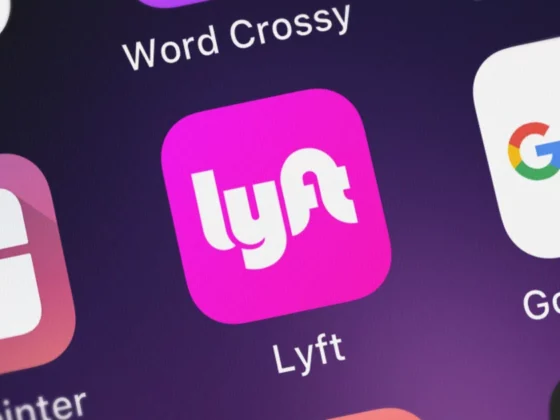AI is everywhere.
How much so?
A brand-new McKinsey report puts a number on it: up to 90% of companies now use AI in at least one business function.
In other words, we’ve officially reached mass adoption.
- Now, in all fairness, most of that adoption (62% to be exact) is still in the experimental stage.
- Companies everywhere are trying to figure out what AI can actually do for them.
Which brings us to our key research piece today.
Not a single week passes without major travel companies (from booking platforms to airlines and emerging tech startups) announcing new AI features designed to “revolutionize the travel experience.”
The AI noise has become so constant that even the most dedicated observers might be tempted to tune it out (we’ve been there too; then remembered that’s literally what we get paid for).
So, to cut through the chaos, we sat down as the TNMT Team to identify the most interesting AI use cases along the traveler journey as of today (which, in AI years, probably means they’ll feel outdated in a few weeks). Think of it as our flight plan through the AI noise: a curated map of the existing use cases we find most relevant (and genuinely exciting) for every professional in Travel and Mobility Tech.
So, without further ado, let’s dive into our selection of AI examples.
For context, we’ve broken the traveler journey down into eight major stages, starting with inspiration and planning, and ending with post-trip activities (including loyalty plays that get travelers thinking about their next trip).
- For each of these eight stages, we’ve selected three concrete examples.
- So that’s 24 real-world AI applications in total.
- And yes, these are real products, not theoretical agentic concepts that might happen someday.
Below, we’ll walk you through all 24 examples in a bit more detail: what each company does, where along the journey it fits, and how you can explore them further through their respective websites and company pages.

Step 1: Let’s start with Inspiration & Planning
This is where most of the AI activity is taking place.
No surprise: GenAI excels at curating, condensing, and conversing, so exactly what travelers need when they’re still dreaming about their next trip.
It’s why an estimated 40% of travelers worldwide already use AI-based tools for trip planning.
Here are three real-world examples that stand out:
1. Mindtrip: The AI trip planner with creator power
There’s no shortage of chat-based trip planners (including those from airlines), but Mindtrip has serious momentum with more than $20 million USD in VC funding in its pocket and over one million monthly visits between July and September 2025.
Two features make it unique:
- The Creator Program lets anyone design itineraries or guides and earn passive income when others use them to book trips, essentially an AI-powered creator economy blending social media, affiliate marketing, and travel planning.
- With its cross-platform inspiration, travelers can save content from Instagram, TikTok, YouTube, and even Google Pins directly into Mindtrip, creating a single home for travel inspiration that turns ideas into bookable plans.

2. Expedia’s trip matching on Instagram
One of travel tech’s OGs has gone fully social.
Expedia’s “Trip Matching” feature on Instagram lets users DM a Reel for inspiration, and AI instantly suggests a trip that mirrors its vibe, setting, and aesthetic.
It’s an (almost) frictionless bridge between social discovery and travel booking.

3. Google Maps is turning screenshots into itineraries
Google Maps’ new “screenshot” list feature, powered by Gemini, automatically identifies places from your saved screenshots of travel content.
- Take a screenshot of a place or post you like.
- Turn on the new screenshot feature in Maps.
- The AI detects (almost) all the mentioned destinations, so you can review, save, and share them as a list with your travel buddies.
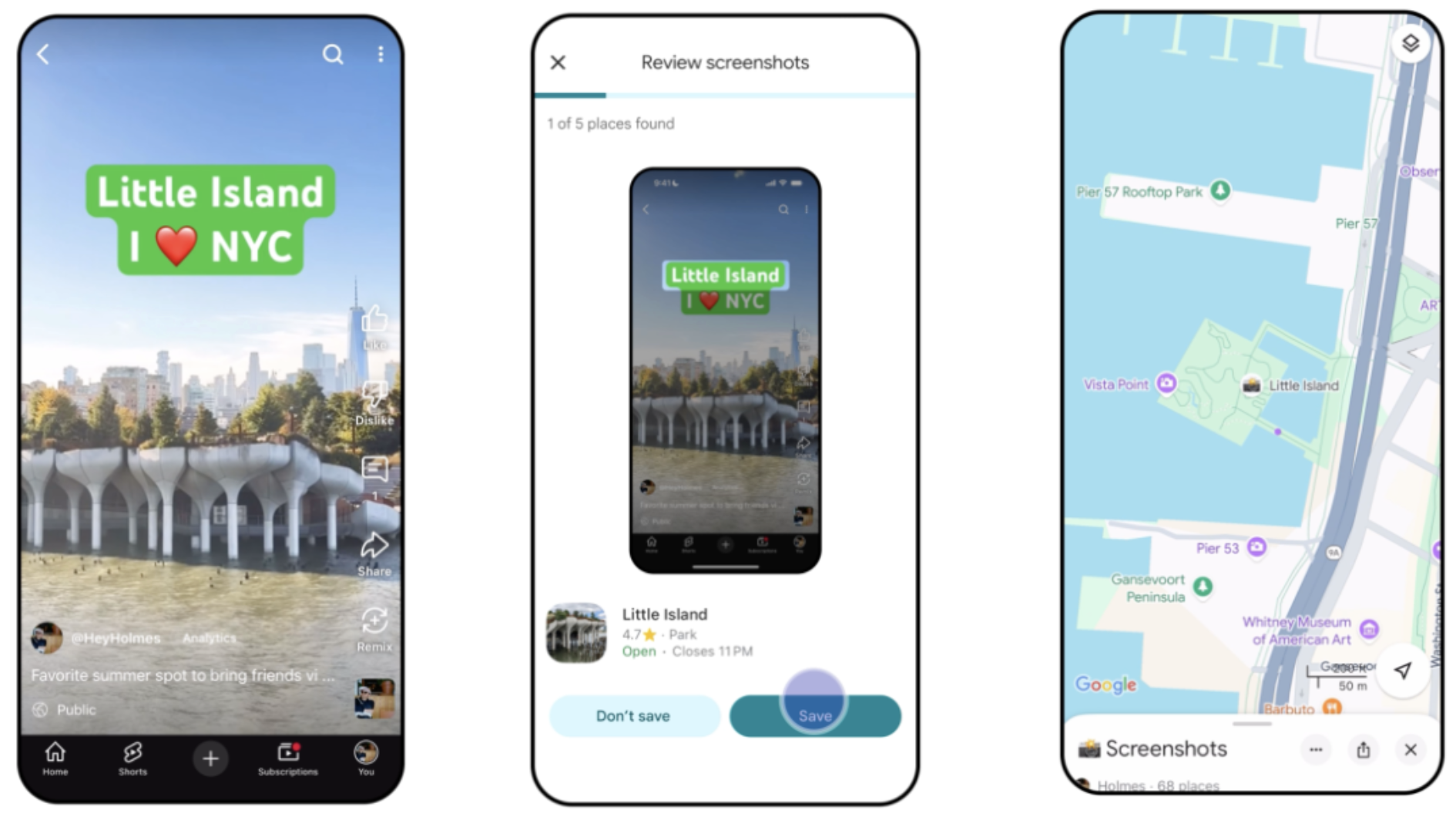
And that’s just the start. Let’s now look at the travel booking stage.
Step 2: Booking and Purchase
Since the introduction of ChatGPT in November 2022, the booking moment has been mostly disconnected from the inspiration and planning stage within AI interfaces.
But that gap is closing as we speak. Thanks to advances in agentic AI, travelers can now move from idea to itinerary to purchase in one continuous flow (e.g., via Expedia’s integration within ChatGPT).
Here are three real-world applications showing how AI is transforming travel booking:
1. IndiGo: Booking inside the airline chat
India’s largest airline has built one of the industry’s most advanced GenAI chatbots.
It doesn’t just answer questions or help with check-ins; it allows travelers to search, book, and manage flights directly inside the chat interface. An (almost) frictionless experience that hints at how “zero-click booking” could look in practice.

2. Airbnb is predicting traveler satisfaction
Airbnb’s AI-driven search ranking model predicts traveler satisfaction by analyzing millions of signals across reviews, pricing, and traveler preference patterns.
The result:
- More relevant listings, higher conversions, and a booking flow that feels almost personally curated.
- A powerful reminder that AI also indirectly reshapes how we book travel.
3. Turkish Airlines is building for the agentic future
Turkish Airlines is one of the first carriers to develop and publicly release an official MCP server, paving the way for agentic AI assistants to autonomously book, modify, or manage reservations.
It’s a strategic move that could redefine how travelers interact with airlines in an AI-first world.

Next up in the journey: pre-trip preparation, so everything travelers do before they leave home.
Step 3: Pre-Trip Preparation
AI is increasingly showing up before the trip even begins, for example, in that crucial window when travelers are getting themselves ready, double-checking logistics, and reducing uncertainty.
Travelers clearly value support along this process.
According to a recent Qlik survey among U.S. travelers, four in 10 say AI features are most helpful for identifying real-time travel updates related to traffic, weather, or potential delays.
Here are three concrete AI-powered tools we find especially interesting during the pre-trip stage:
1. Sherpa’s automated travel documentation
Sherpa is an AI-powered, white-label documentation assistant embedded directly into airline booking flows (used by Air Canada, Lufthansa, United, and many others).
- It auto-checks entry rules, visa requirements, and health documentation based on traveler details, and even enables eVisa and eTA applications as integrated ancillary services.
- For many airlines, Sherpa now handles one of the most anxiety-prone parts of travel before travelers even pack their bags.

2. TripIt Pro’s proactive risk alerts
TripIt Pro by SAP Concur uses AI to monitor beyond flight-specific updates.
- Its Risk Alerts track broader incidents that might affect a traveler’s itinerary: weather disruptions, political events, strikes, tech outages, airport-level incidents, and more.
- It’s a level above airline push notifications, giving travelers a fuller situational picture so they can make smarter rebooking and routing decisions.

3. Taalhammer offering personalized language prep
For travelers who like to learn a bit of the local language before a trip, Taalhammer uses an AI-driven spaced-repetition system that automatically identifies which words or phrases you’re struggling with.
It emphasizes weak spots and lets you build a custom phrasebook tailored to your trip, from ordering food to navigating transit.

Next, let’s move from “getting ready” to getting moving.
Step 4: Airport Experience
If there’s one part of the journey where classic AI (not necessarily GenAI) is quietly transforming everything behind the scenes, it’s the airport.
From biometrics to computer vision to predictive operations, AI is reshaping how passengers move through terminals, and travelers want it.
According to IATA, 73% of travelers say they prefer biometric processing over manual passport checks.
Here are three airport AI applications we find especially inspiring:
1. Changi Airport’s biometric everything and smarter wayfinding
Changi is rolling out biometric immigration checks for 95% of travelers by 2026, enabling fast, document-free identity verification.
Beyond border control, Changi’s app integrates AI-powered indoor navigation, which:
- Highlights crowd congestion,
- Generates personalized, step-by-step navigation to one’s gate,
- And calculates walking time dynamically.
It’s one of the most advanced airport navigation stacks globally and a glimpse at what fully AI-orchestrated passenger flow may look like.

2. Frankfurt Airport’s walk-through security and AI-powered baggage scanning
Frankfurt fully rolled out AI-enabled walk-through security scanners in early 2025.
Instead of standing in awkward poses, passengers simply walk through at normal speed while advanced AI analyzes scans for prohibited items in real time.
On the baggage side, Frankfurt has used the LuRAI computer vision system since 2022, eliminating 95% of baggage misalignments, significantly reducing delays and mishandled bags.
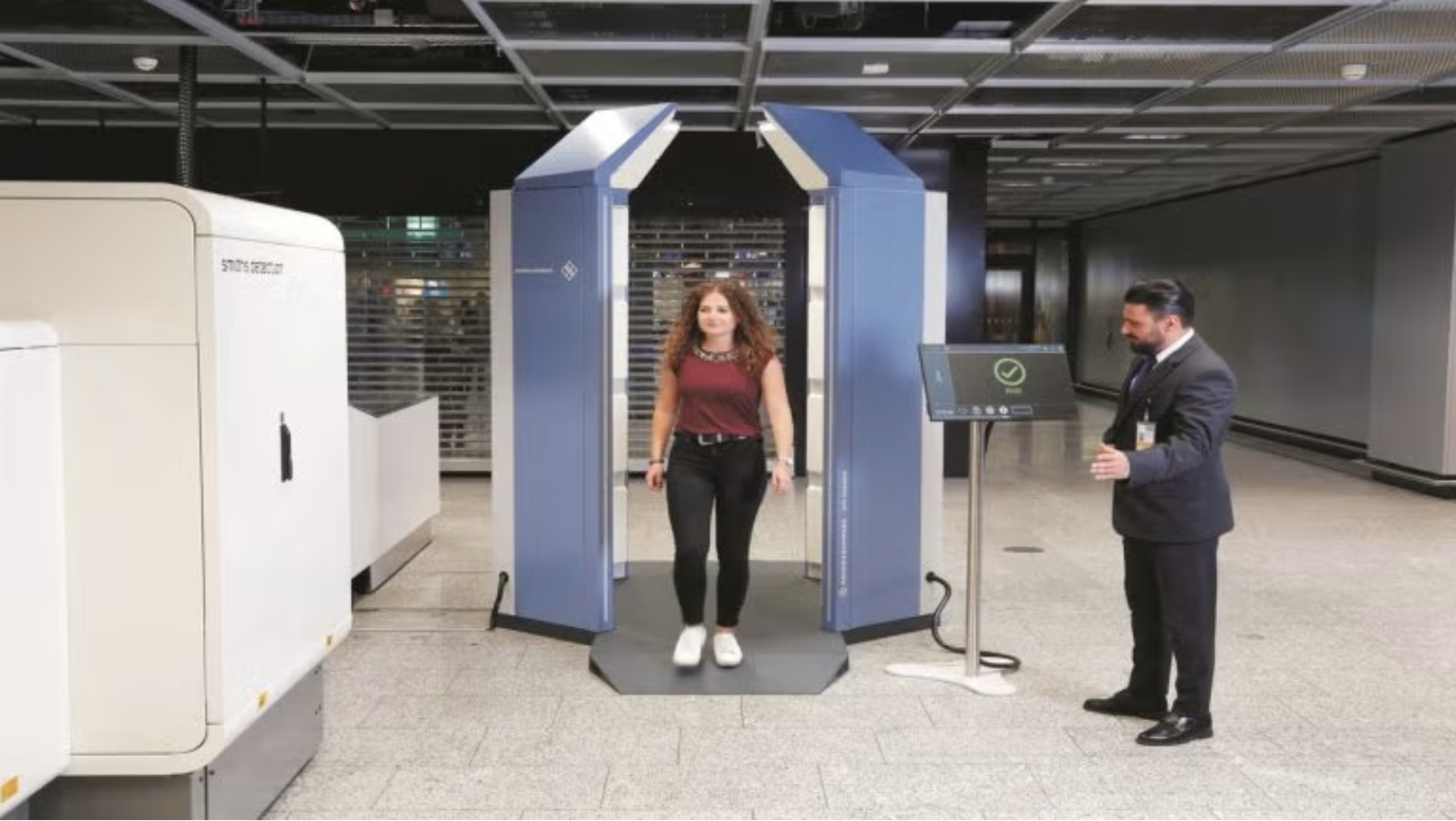
3. Amadeus’ automated disruption recovery
Amadeus’ Passenger Recovery System, used by Air Canada, transforms one of the most painful moments in travel: disruptions.
The system analyzes real-time operational data; identifies affected passengers; calculates optimal recovery plans; automatically rebooks 90% of passengers within 10 minutes; and sends instant notifications.
Before this, recovery workflows could take up to 12 hours. For travelers, this is the difference between being stranded and being instantly back on track.
Next up: let’s move from the terminal to the sky with the in-flight experience.
Step 5: In-Flight Experience
Once onboard, passengers are increasingly supported by AI-powered recommendation engines, from what they watch to how aircraft are routed and even how onboard payments are processed.
Here are three examples we like the most:
1. Immfly’s smarter onboard payments
Immfly powers the electronic point-of-sale (EPOS) systems on many airlines, and its latest upgrade includes AI-driven security checks and payment reprocessing.
While the exact mechanics aren’t disclosed, the system is designed to detect fraud, reduce declined transactions, and increase onboard revenue; all without passengers noticing a thing.

2. Flyways AI (Airspace Intelligence): AI-optimized flight paths
Since 2021, Alaska Airlines has used Airspace Intelligence’s Flyways AI dispatching platform.
According to the airline, 55% of its 4+ hour flights that received AI-suggested route optimizations achieved a 3–5% reduction in fuel consumption, thereby saving 1.2 million gallons of fuel in 2023 alone.
That’s good for the planet, good for the P&L, and invisible to passengers, except for the occasional earlier-than-expected arrival.
3. Delta’s personalized entertainment and offers
Delta’s onboard product Delta Sync uses AI to learn from SkyMiles members’ viewing history and recommend entertainment tailored to each traveler.
The system also uses AI to curate personalized retail and service offers from Delta’s partners, steadily turning in-flight entertainment into a dynamic, data-driven personalization engine.
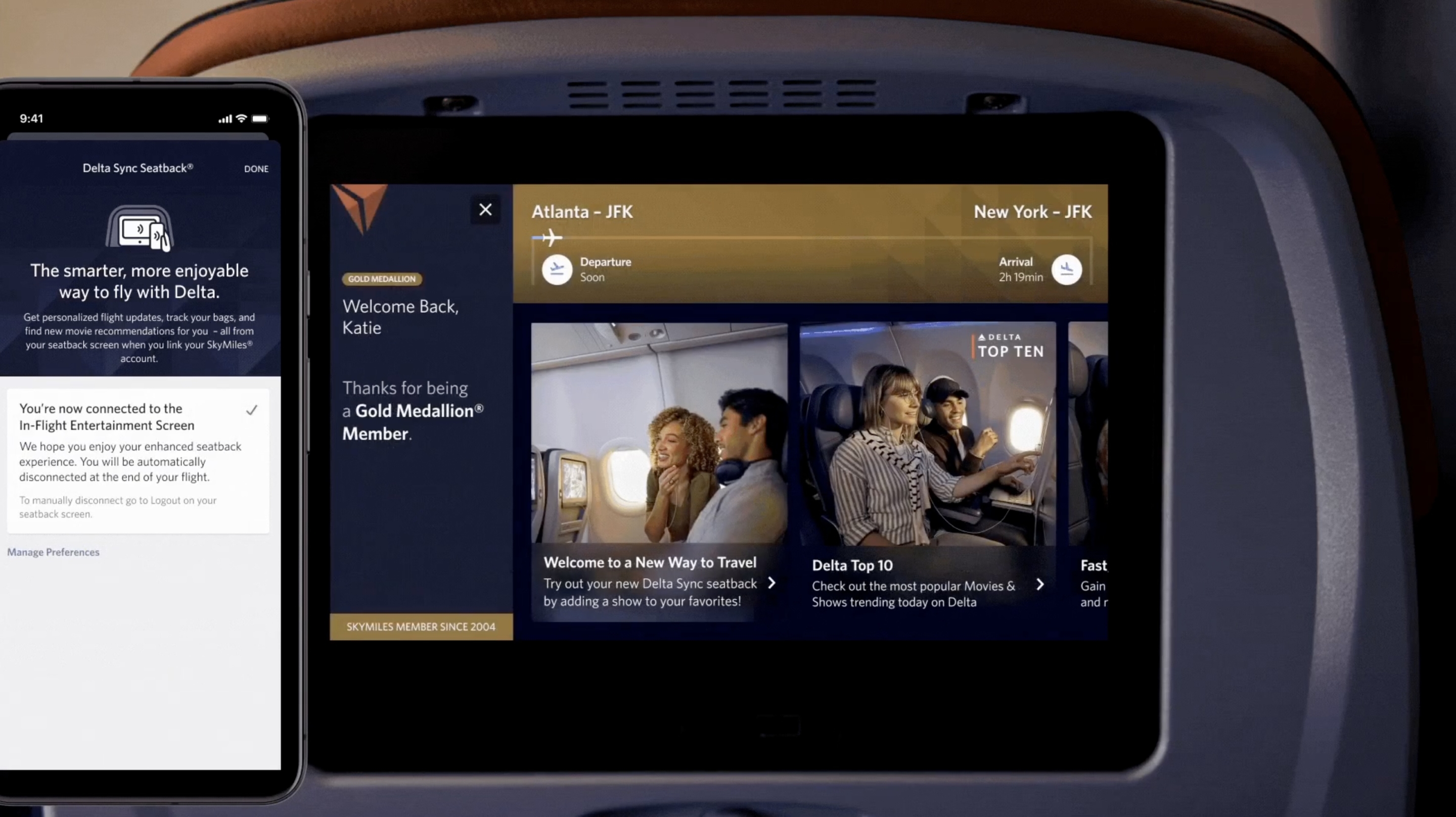
Next up: what happens once the wheels hit the ground?
Step 6: Ground Transport
Once passengers land, the next challenge is getting around, and here, too, AI is reshaping the experience.
In full transparency, the solutions below aren’t limited to airport transfers; they operate across the broader mobility ecosystem. But their impact on how travelers move from airport to city (and back again) is becoming more real by the week.
1. Waymo: Autonomous rides at scale
Waymo has quietly become one of the world’s largest autonomous mobility operators, now completing almost one million monthly rides (a 150% increase between August 2024 and April 2025).
For travelers, this will likely mean increasingly reliable, safe, and consistent airport transfers and in-destination movement, especially in markets like Phoenix, San Francisco, and Los Angeles.
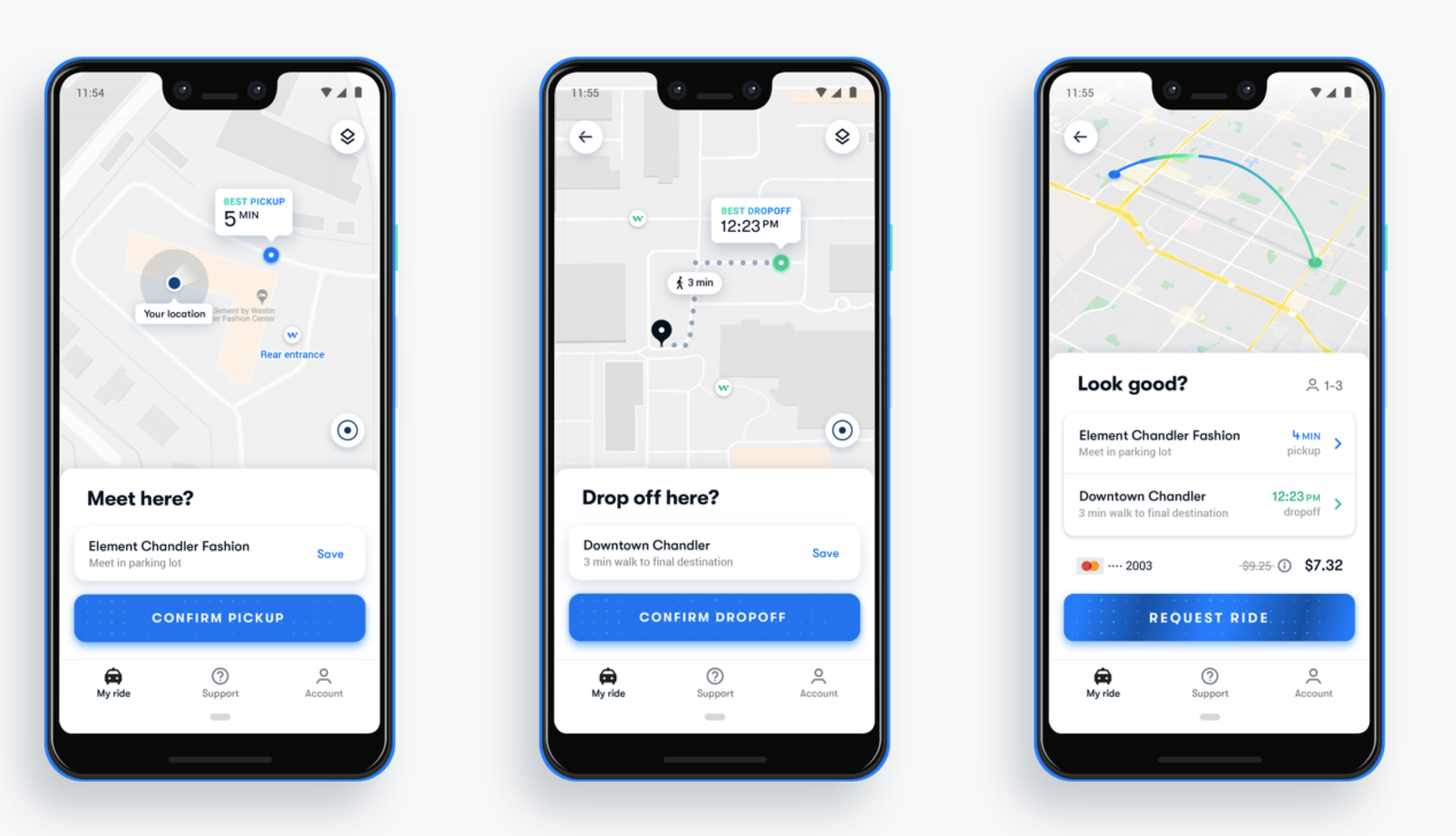
2. Hertz’s AI-powered damage detection
This one is a big one for air travelers. Who hasn’t returned a rental car at an airport, holding their breath over potential damage disputes?
Hertz is rolling out UVeye’s AI tunnel scanners to 100 U.S. airports by the end of 2025.
The system detects vehicle damage in seconds, replacing manual inspections and dramatically reducing disputes, wait times, and checkout delays, which is a huge win for travelers sprinting to catch their next flight.

3. Lime: Smarter micromobility for travelers
This final example is more niche, referring to mobility once travelers have checked into their hotel and are ready to explore the city.
Micromobility provider Lime uses AI to forecast demand hotspots for its e-scooters by analyzing weather, events, and historical usage to optimize fleet rebalancing.
In tourist-heavy cities like Paris (where up to 40% of riders are tourists), this ensures scooters are available exactly when and where travelers need them most.
Next up: let’s look at how AI steps in once travelers reach their destination, shaping the in-destination experience.
Step 7: In-Destination Activities
Once travelers have arrived and settled in, AI becomes especially relevant.
According to Booking.com’s Global AI Sentiment Report, travelers most commonly use AI for:
- Translation capabilities (45%).
- In-destination activity suggestions (44%).
- Restaurant recommendations (40%).
So this stage is a natural hotspot for AI experimentation and real value creation.
Here are three in-destination AI applications we find most intriguing:
1. Otonomous Hotel: the AI-powered personalized hotel stay
Las Vegas’s Otonomous Hotel pushes personalization into new territory.
Guests can opt into a pre-stay quiz and allow the system to scan their social media presence so the hotel can tailor the experience around their language preferences, dietary needs, interests, and habits.
The AI doesn’t stop at check-in: it adapts throughout the stay by learning preferred room temperatures, tracking onsite spending, and generating personalized offers and service adjustments in real time.
It’s one of the first real-world tests of what a fully AI-curated hotel stay might look like.
2. GetYourGuide’s machine-learning recommendations for things to do
GetYourGuide’s activity recommendation engine uses machine-learning models that evaluate signals such as prior searches, bookings, browsing patterns, and in-app interactions to predict which experiences travelers are most likely to love.
It essentially turns the massive “things to do” universe into a personalized shortlist, helping travelers cut through the overwhelm and book experiences that fit their interests (even if they didn’t know they existed).
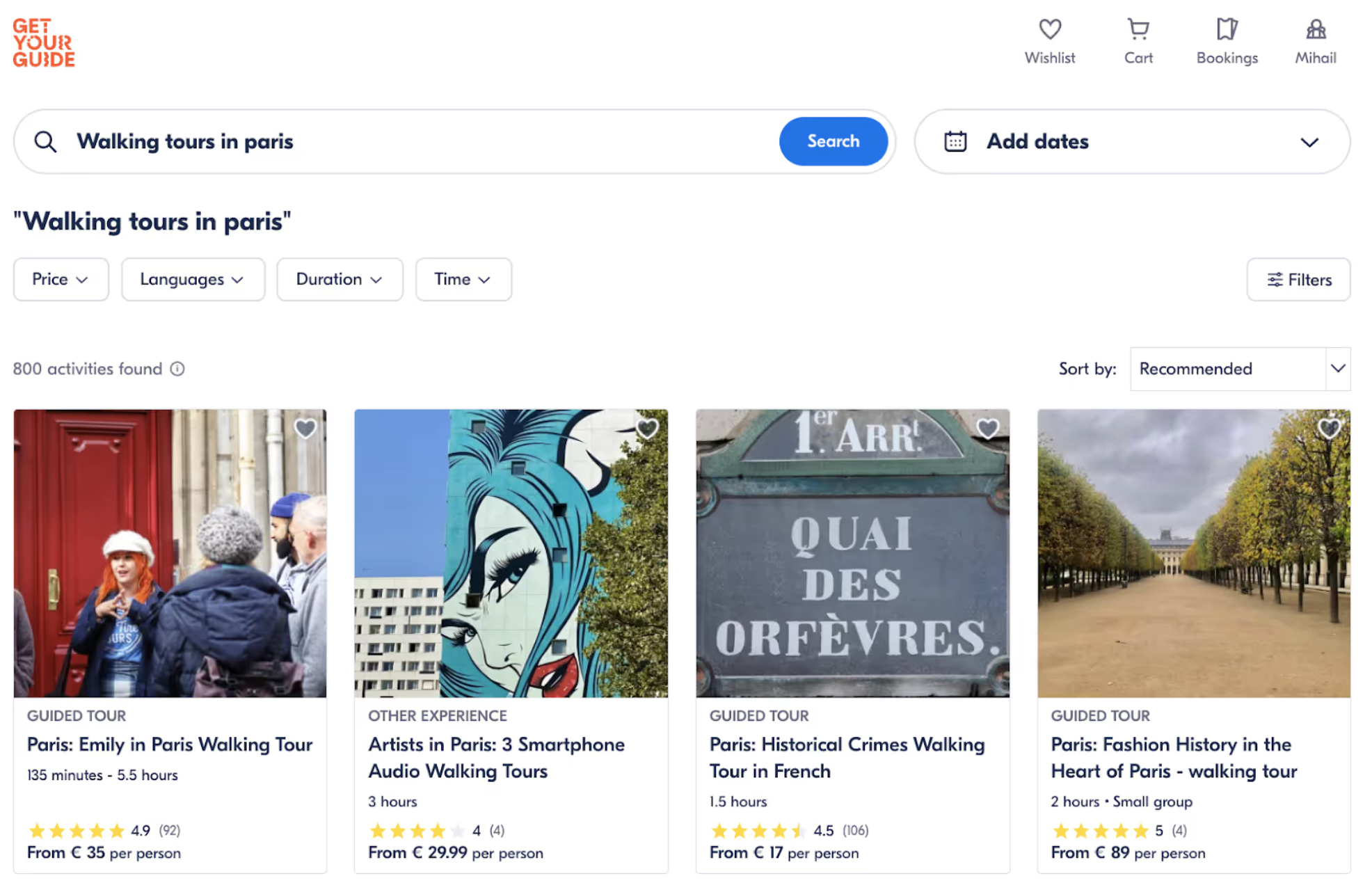
3. Trip.com’s on-trip assistance in your pocket
Trip.com’s on-trip AI widget is a small feature with massive utility. Here is what it offers:
- instant translation
- currency conversion
- menu assistance that explains dishes in context, not just literal word-for-word translations
Especially the latter emphasizes how AI is designed as a real-time companion for travelers navigating new environments.
Next up is the final stage: post-trip engagement, where AI keeps travelers inspired for whatever comes next.

Step 8: Post-Trip and Loyalty
The journey doesn’t end when travelers return home.
In many ways, the post-trip phase is where AI becomes most valuable for travel brands, helping them interpret feedback, predict behavior, and keep travelers engaged for the next booking cycle.
Here are three AI applications shaping this stage:
1. Qualtrics: AI-powered feedback analysis for JetBlue and Singapore Airlines
Qualtrics’ CustomerXM solution is used by airlines like JetBlue and Singapore Airlines to digest massive volumes of feedback (from free-text reviews to NPS comments to social media posts).
The AI surfaces emotion signals, trending issues, and drivers of satisfaction, enabling travel brands to trigger personalized retention actions and close the loop much faster than manual teams can.
2. Satori Analytics: Predicting airline customer churn
Satori worked with a European airline (identity undisclosed) to build a machine-learning model capable of predicting passenger churn with 85% accuracy.
Armed with this insight, the airline can immediately target high-risk customers with personalized retention offers like discounts, tailored outreach, and tailored perks before they book elsewhere.
3. MakeMyTrip: Automated, behavior-based post-trip engagement
MakeMyTrip uses machine learning to segment customers dynamically and automate post-trip campaigns based on traveler behavior and journey context.
Examples:
- Right after a trip → a “welcome home” hotel promo.
- During holidays → surprise bonus points for high-value customers.
- When browsing again → personalized nudges aligned with past travel patterns.
It’s AI fuel for loyalty, delivered wisely at the right moment.
And that brings us full circle.
The traveler journey may be linear on paper, but AI is making it increasingly cyclical, with each trip fueling the next in smarter, more personalized ways.






